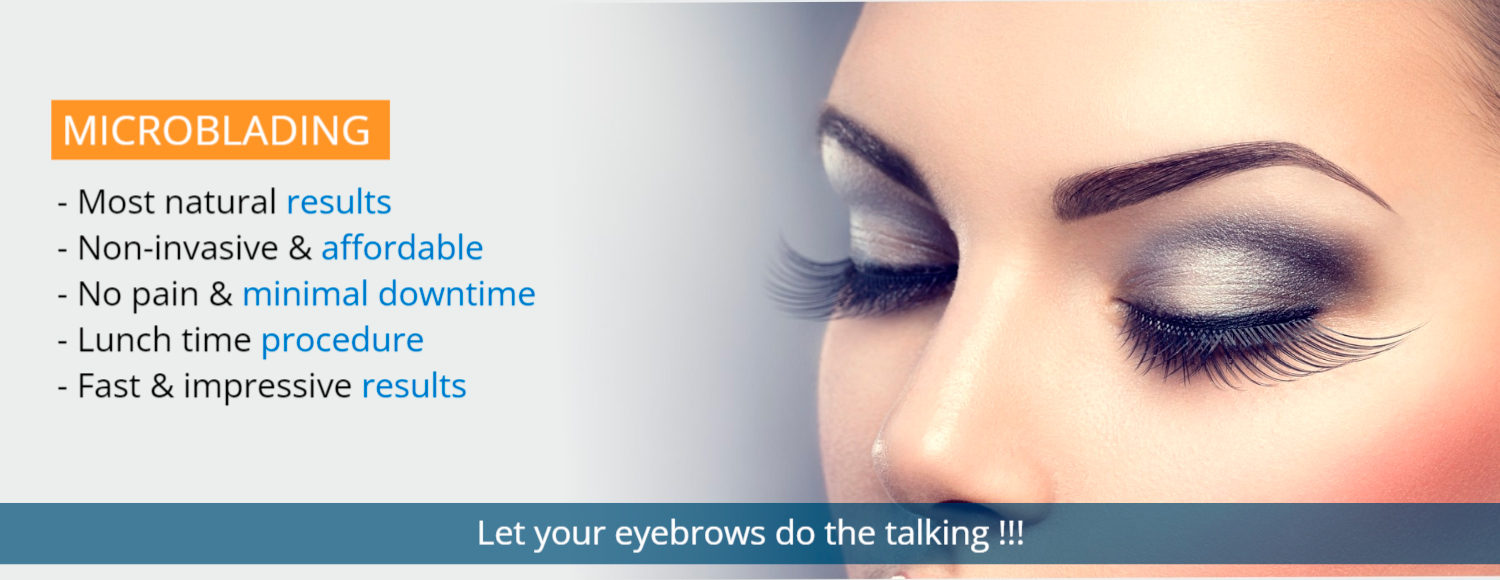Microblading, also popular by other names like Microshading/ Micropigmentation is a means of semi permanent tattooing to enhance the eyebrow architecture. It is designed as per the patient needs to achieve best eye brow shape customized to each face. The procedure involves the creation of fine, realistic, natural hair like strokes with a disposable, single use, sterile blade. It is different from Permanent eyebrow tattooing that the pigment is imparted in the more superficial layers of the skin, and gives a more natural appearance of eyebrows. .
Treatment Procedure
The shape, density of the eyebrow and the colour of the pigment to be used may be decided by the patient after discussing with the doctor, to give a more natural look. A Microblading ruler is used to mark the shape of eyebrow.
After cleaning the area with antiseptic solution, a numbing cream is applied for 15-20 minutes. Once the area is made numb, fine hair like strokes are created in a manner to correlate with the natural hair direction with a sterile, single use, disposable blade, followed by pigment application for 5 minutes.
A touch up procedure may be required after 4-6 weeks, to fill in the gaps if left any. The patient is usually comfortable during the procedure, but may feel slight pain later on, which will be taken care by giving anti-inflammatory medications.
A one-week course of antibiotic is usually given following the procedure.
Post procedure instructions
Immediate: It is advised not to pick or scratch the area. Gentle washing of the face followed by moisturizer application is advised. Steaming, sauna, hot showers and strenuous exercises are advised to avoid for a minimum of 7 days. There might be scab formation which falls off in 7-10 days. The pigment is usually 30-40% darker for 7-10 days immediately after the procedure, but there will be flaking and fading of the pigment further. It takes 3-4 weeks following procedure to achieve desired shape and colour, and then a touch-up session is done if at all required.
Long term: It is advised to cover the treated area with a thick layer of petroleum jelly before undergoing procedures like chemical peels, Resurfacing lasers, Intensed pulse light therapy (IPL), UV exposure etc. Topical creams containing retinol, Hydroquinone are to be avoided over tattooed area, as it may enhance the fading of tattoo.
Side effects:
Mild pain and minimal oozing of blood are often expected during the procedure, which lasts for about 10-15 minutes. Like any other tattoo, foreign body granulomatous reactions can occur following microblading, very rarely.
When should you go for Microblading:
- Less natural density of eyebrows
- Suffering from alopecia
- Loss of eyebrows due to scarring
- Desiring natural results for fuller eyebrows
What are the contraindications to the procedure:
- Patient under 18 years of age
- Diabetes (may hamper the healing process)
- pregnant or lactating women
- tendency for hypertrophic scar and keloid formation
- skin diseases such as psoriasis, eczema, active infection and undiagnosed rashes or blisters on the site that is to be treated
- history of known allergies to makeup or colors
- tendency of post inflammatory hyper pigmentation
- transmittable blood conditions like HIV or Hepatitis
- history of glaucoma
- hemophiliacs and people on medications like blood thinners, thyroid medications
- uncontrolled high blood pressure or heart diseases
- active skin cancer in the area to be tattooed
How long the effects last for:
Like with any other tattoo, the pigment fades off with time. Usually, the effect lasts for 1-1.5 years, requiring touchup sessions after this time period.
How to remove or undone the pigment:
Lasers can be done to remove the pigment. Q switched Nd YAG lasers and Intensed Pulsed Light (IPL) therapy can be done depending on the colour of the pigment.

